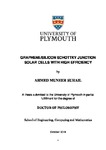GRAPHENE/SILICON SCHOTTKY JUNCTION SOLAR CELLS WITH HIGH EFFICIENCY
| dc.contributor.supervisor | Pan, Genhua | |
| dc.contributor.author | SUHAIL, AHMED MUNEER | |
| dc.contributor.other | School of Engineering, Computing and Mathematics | en_US |
| dc.date.accessioned | 2019-11-19T15:59:01Z | |
| dc.date.available | 2019-11-19T15:59:01Z | |
| dc.date.issued | 2019 | |
| dc.identifier | 10464909 | en_US |
| dc.identifier.uri | http://hdl.handle.net/10026.1/15168 | |
| dc.description.abstract |
Silicon p-n junction solar cells have a power conversion efficiency (PCE) up to 12%. Graphene, which has unique properties is an excellent material for solar cells with the potential to achieve higher PCEs. Since 2009, researchers have started to integrate CVD-graphene with Si substrates to develop Schottky junction solar cells with potentially higher PCE. However, there are several challenges remaining in designing and fabricating these cells. In this project, a novel graphene/Si Schottky junction solar cell with a back-contact structure was fabricated to increase the active area and also enable a texturing process to be implemented on the front of Si substrates. With this structure, a graphene layer and contacts are placed on the back-side of Si substrates, which reduces the optical loss from the front contact. Thus, the active area of graphene/Si Schottky junction solar cells is increased, thereby leading to an improvement in the PCE. By applying the texturing process, the light reflected from the front of Si substrates is reduced, resulting in an additional increase in the PCE. Two novel techniques were also developed to overcome the serious issue of the s-shape J-V behaviour in previous graphene/Si Schottky junction solar cells. Itwas shown that the removal of the PMMA residue left on graphene layers is critical to eliminate the s-shape in the J-V curves as this residue traps charge carriers, leading to the s-shape. In this case, formamide and deep UV (DUV) treatments were employed to transfer residue free CVD-graphene onto Si ii substrates. By reducing the PMMA residue, devices displayed a noteworthy enhancement in the PCE compared with that of untreated devices. As a result of reducing the PMMA residue and applying the texturing process, solar cells with PCE of 10% have successfully been fabricated. This value is a new record for graphene/Si solar cells prepared without chemical doping, and it is about 45% more than those for devices reported so far. To further enhance the device performance, the graphene layer was chemically p-doped, leading to a higher PCE of 14.1%. Hence, the achieved values of PCE in this work are comparable with those of conventional p-n junction solar cells. Additionally, there is a possibility to further improve the performance of graphene/Si Schottky junction solar cells by using multi-graphene layers instead of a monolayer. This further reduces the sheet resistance of transferred graphene layers, leading to a higher PCE. This work presents a feasible way to prepare simpler and higher performance graphene/Si Schottky junction solar cells that are able to sustain the positive influence of graphene in solar cell technology. | en_US |
| dc.description.sponsorship | The Higher Committee For Education Development in Iraq | en_US |
| dc.language.iso | en | |
| dc.publisher | University of Plymouth | |
| dc.subject | Renewable energy-solar cells | en_US |
| dc.subject.classification | PhD | en_US |
| dc.title | GRAPHENE/SILICON SCHOTTKY JUNCTION SOLAR CELLS WITH HIGH EFFICIENCY | en_US |
| dc.type | Thesis | |
| plymouth.version | publishable | en_US |
| dc.identifier.doi | http://dx.doi.org/10.24382/1217 | |
| dc.rights.embargoperiod | No embargo | en_US |
| dc.type.qualification | Doctorate | en_US |
| rioxxterms.version | NA |
Files in this item
This item appears in the following Collection(s)
-
01 Research Theses Main Collection
Research Theses Main


